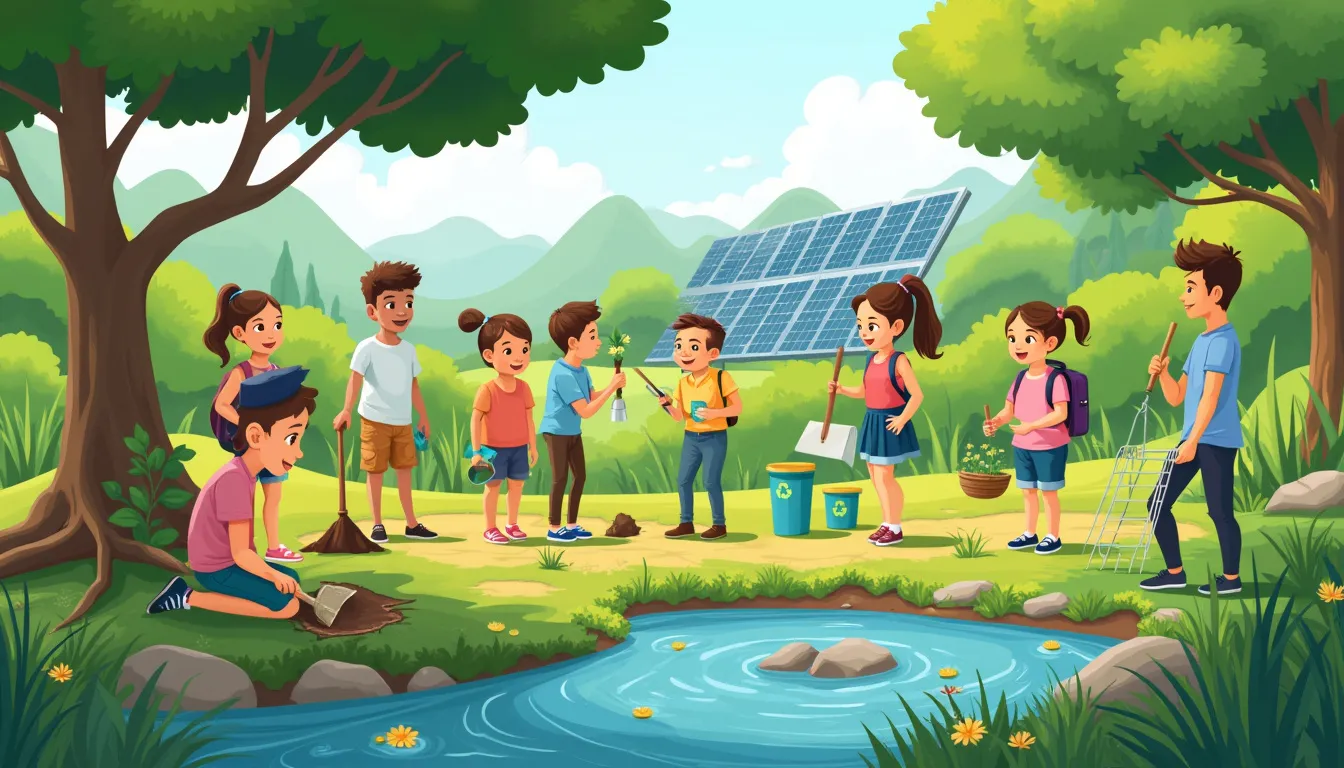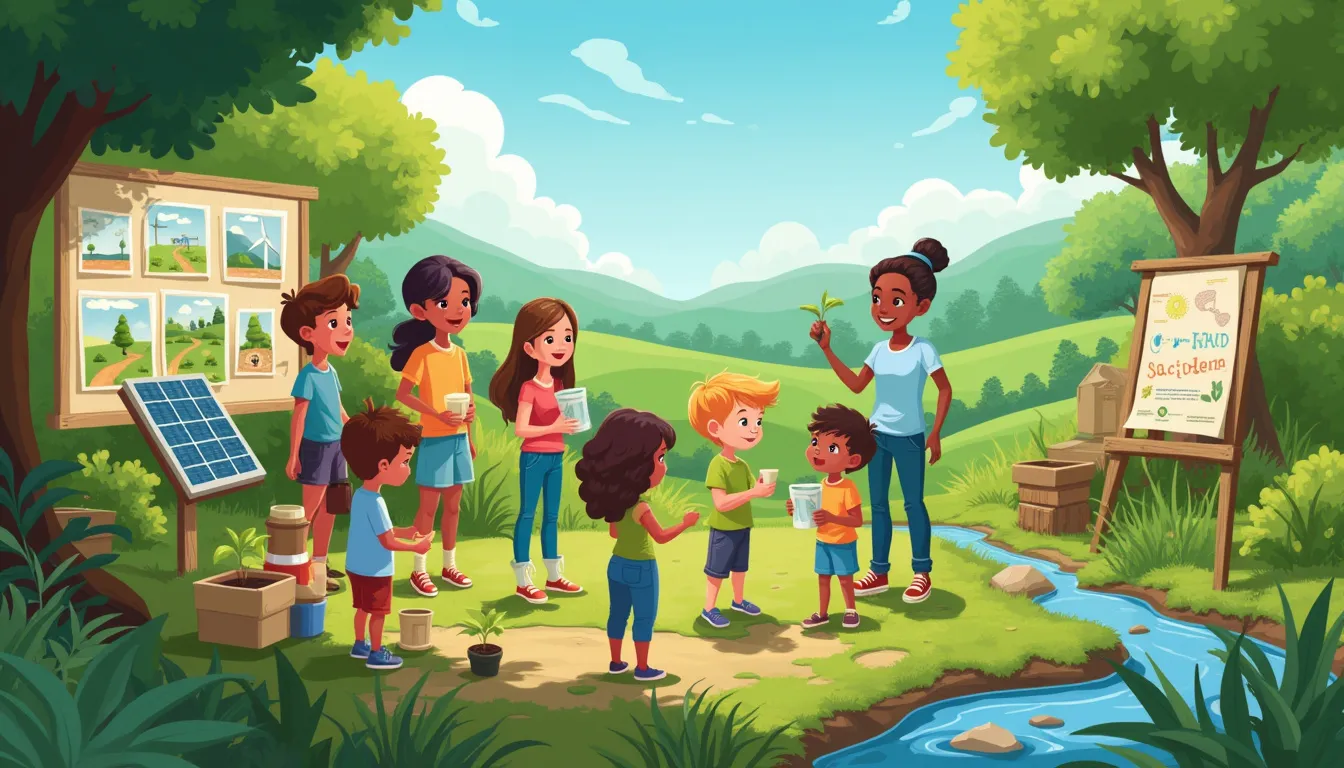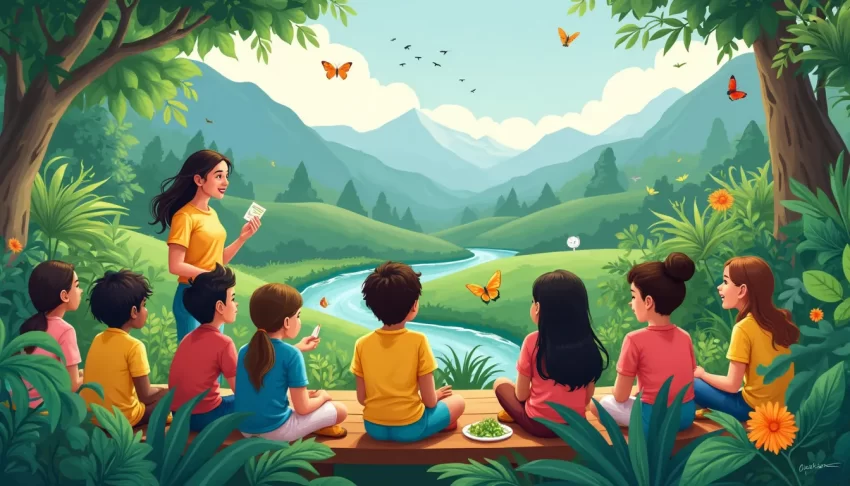In an era where climate change, biodiversity loss, and pollution are household terms, the role of environmental education has never been more crucial. Environmental education, often defined as the teaching of individuals and communities about the natural environments and the pressing issues that threaten them, is the cornerstone of fostering a generation that is not only aware but also proactive in protecting our planet. This article delves into the essence of environmental education, tracing its roots and evolution over time, and highlighting its unparalleled relevance in the 21st century.
Historically, the concept of educating people about the environment has evolved significantly. From indigenous practices that harmonized living with nature, to the establishment of formal educational systems in the 20th century that began incorporating environmental topics, the trajectory has been marked by a growing awareness of the planet’s finite resources and the urgent need to protect them. Today, environmental education is more than just a subject in school; it is a comprehensive approach that integrates awareness, advocacy, and action, crucial for sustainable development.
In modern times, the scope of environmental education has expanded beyond classrooms to encompass community programs, workplace initiatives, and digital platforms. This broadened approach ensures that individuals of all ages, backgrounds, and professions are equipped with the knowledge and skills to contribute to environmental sustainability. It empowers both individuals and communities to make informed decisions, adopt sustainable practices, and drive collective action toward environmental conservation.
As we navigate the complexities of the 21st century, environmental education serves as a powerful tool to enhance critical thinking and problem-solving skills. By understanding the intricate relationships between human activities and natural systems, learners can develop innovative solutions to mitigate environmental challenges. This comprehensive understanding is vital not only for the health of our planet but also for the well-being of future generations.
Embarking on this journey of understanding, let us explore the multifaceted benefits of environmental education, the strategies for its effective implementation, and the challenges that need to be addressed to ensure its success. Through collaborative efforts and continued commitment, we can harness the power of environmental education to create a more sustainable and resilient world.
Introduction to Environmental Education
Definition and Scope of Environmental Education
Environmental education encompasses the teaching and learning processes that focus on the environment and how we can sustainably manage our impact on it. According to the UNESCO, environmental education aims to develop a well-informed population that can make responsible decisions for the protection and improvement of the environment. The scope of environmental education is vast, ranging from classroom-based curricula to community projects and policy advocacy efforts.
At its core, environmental education empowers people with the knowledge, skills, and attitudes necessary to understand the complexities of the natural world. It encourages critical thinking about environmental issues and motivates individuals to participate in resolving these challenges. For businesses, this form of education can inform strategies that reduce environmental impact and enhance corporate social responsibility.
Historical Context and Evolution
The concept of environmental education has evolved significantly over the past century. It gained traction in the 1960s and 1970s, amid rising global awareness of environmental degradation and the urgent need for conservation. Initiatives like the 1972 United Nations Conference on the Human Environment in Stockholm and the subsequent establishment of World Environment Day served as catalysts in this movement.
Early environmental education typically focused on nature studies, emphasizing a direct connection with the natural world. As time progressed, it incorporated broader issues such as pollution, climate change, and sustainable development. The 1992 Earth Summit in Rio de Janeiro marked another critical juncture, leading to the creation of Agenda 21, a comprehensive plan to promote sustainable development worldwide. In the years since, environmental education has adapted to address emerging challenges and technological advancements, moving from simply raising awareness to fostering actionable change.
Relevance of Environmental Education in the 21st Century
Environmental education is more relevant today than ever before. The pressing issues of climate change, biodiversity loss, and resource depletion demand a population that is not only aware of these problems but also equipped to address them. This type of education is integral to achieving the United Nations’ Sustainable Development Goals (SDGs), particularly Goal 13 (Climate Action), Goal 14 (Life Below Water), and Goal 15 (Life on Land).
In the 21st century, environmental education can play a pivotal role in shaping a sustainable future. For instance, schools that integrate environment-focused curricula can cultivate environmentally conscious generations. Students learn the importance of conservation, renewable energy, waste management, and sustainable agriculture. Moreover, businesses that embrace environmental education as part of their corporate training program can foster a culture of sustainability, improving their public image and aligning with consumer expectations for eco-friendliness.
This century also brings an array of modern tools that can enhance environmental education. Interactive technologies such as virtual reality and internet-based platforms can simulate environmental impacts and provide immersive learning experiences. These innovations make environmental education more engaging and accessible, ensuring that critical information reaches a broader audience.
In conclusion, the journey of environmental education from its early roots to its present-day application demonstrates its increasing importance. By continuing to evolve and adapt, it stands as a cornerstone in our collective efforts to build a more sustainable future.

Benefits of Environmental Education
Promoting Sustainable Development and Conservation
The role of environmental education in fostering sustainable development and conservation cannot be overstated. By integrating environmental education into curricula, we equip individuals with the knowledge and skills necessary to make informed decisions about natural resource use and conservation strategies. For instance, schools that incorporate lessons on recycling, water conservation, and energy efficiency instill values and practices that students carry into adulthood. This not only reduces the ecological footprint of future generations but also promotes a culture of environmental stewardship.
One inspiring example is the Green School in Bali, Indonesia, known for its holistic and hands-on approach to environmental education. Students at the Green School engage in real-world projects like organic farming and renewable energy initiatives, connecting theoretical knowledge with practical application. This approach demonstrates how environmental education can drive sustainable practices and foster innovative solutions to ecological challenges.
Empowering Individuals and Communities
Environmental education empowers individuals and communities by providing them with the tools to advocate for and implement positive environmental change. Knowledge is power, and when people understand the impact of their actions on the environment, they are more likely to take proactive steps to protect it. This empowerment can be seen in community-led conservation projects and grassroots movements that have made significant strides in environmental protection.
Consider the case of the Chipko Movement in India, which began in the 1970s. Local villagers, armed with knowledge gained through environmental education, mobilized to protect their forests from deforestation by physically hugging the trees. This movement not only preserved vital ecosystems but also set a precedent for community-driven environmental activism worldwide.
In a contemporary context, environmental education programs in urban areas often engage residents in initiatives such as community gardens, clean-up drives, and urban forestry projects. These activities foster a sense of collective responsibility and demonstrate the power of informed, united action in achieving environmental goals.
Enhancing Critical Thinking and Problem-Solving Skills
Another significant benefit of environmental education is its role in enhancing critical thinking and problem-solving skills. Environmental issues are often complex and multifaceted, requiring individuals to analyze information, consider various perspectives, and devise innovative solutions. By tackling environmental challenges through education, learners develop essential skills that are transferable to many other areas of life.
For example, students in environmental studies programs frequently engage in project-based learning where they must assess local environmental issues and propose sustainable solutions. These projects might include designing a green roof for a school building, developing a plan to reduce plastic waste in the community, or assessing the impact of local industrial activities on air quality. In the process, students enhance their abilities to critically evaluate information, collaborate with peers, and think creatively – skills that are invaluable in the rapidly evolving modern world.
Incorporating environmental education into the business sector also yields substantial benefits. Companies that prioritize environmental training for their employees often see increased innovation and improved problem-solving capabilities. Employees who are well-versed in sustainability practices are more likely to identify and implement efficient, eco-friendly solutions that benefit both the company and the planet.
A notable example can be seen in the corporate approach of Interface, a global manufacturer of modular floor coverings. Through their Mission Zero initiative, Interface has integrated environmental education into their corporate culture, encouraging employees to develop sustainable products and reduce the company’s ecological footprint. This commitment has not only contributed to environmental conservation but has also driven product innovation and improved the company’s market competitiveness.
Conclusion
By examining the myriad benefits of environmental education, it becomes clear that its impact extends far beyond the classroom. It promotes sustainable development, empowers individuals and communities, and enhances critical thinking and problem-solving skills. As we continue to face complex environmental challenges, the importance of environmental education in fostering a sustainable and resilient future cannot be overstated. Whether in personal life or professional settings, integrating environmental education paves the way for a more conscious and capable society, ready to tackle the pressing issues of our time and build a greener tomorrow.

Implementation Strategies for Effective Environmental Education
To make environmental education (EE) impactful, it’s essential to adopt multifaceted implementation strategies that cater to diverse learning environments and audiences. Here, we’ll delve into some key strategies: integrative curriculum approaches, the role of technology and digital media, and collaborations with environmental organizations and experts.
Integrative Curriculum Approaches
An integrative curriculum approach is at the heart of effective environmental education. Traditional teaching methods often compartmentalize subjects, but real-life environmental issues do not fit neatly into one category. Here’s how integrating EE across various disciplines can spark a more profound understanding and commitment to sustainability:
1. Cross-disciplinary Learning: Combining subjects like science, geography, social studies, and even art promotes a holistic understanding of environmental issues. For example, a lesson on water pollution in a science class can be linked to social studies by exploring its impacts on human communities and integrative creative writing assignments about imaginary journeys of a water droplet. The merging of these fields fosters comprehensive insights and critical thinking.
2. Project-Based Learning: Implementing project-based learning where students engage in real-world environmental issues encourages practical problem-solving skills. Schools can partner with local businesses or community projects to give students hands-on experiences. Projects like building a school garden, conducting local wildlife studies, or initiating recycling programs can solidify theoretical knowledge through concrete actions.
3. Interdisciplinary Collaboration: Encourage collaboration among teachers from different subjects to design integrated lesson plans. For instance, a math teacher might work with a science teacher on a project that calculates carbon footprints, or a language arts teacher may coordinate with a history teacher to examine environmental literature from different eras.
Engaging students through an integrated curriculum not only enriches their learning experience but also encourages them to see environmental issues as interconnected with every aspect of life.
Role of Technology and Digital Media
Technology and digital media play an increasingly crucial role in enhancing environmental education. Here are some actionable ways in which digital tools can make environmental learning more interactive and engaging:
1. Virtual Field Trips: Technology can bring the world to the classroom through virtual field trips to national parks, wildlife reserves, and other ecologically significant locations. Tools like Google Earth and virtual reality (VR) headsets give students an immersive experience that can spark curiosity and a deeper appreciation for the environment.
2. Interactive Learning Platforms: Digital platforms such as educational apps, websites, and e-books can provide interactive quizzes, videos, and simulations. For example, platforms like Kahoot! or Quizlet can be used to create fun, interactive quizzes about recycling processes, while websites like National Geographic Kids offer engaging articles and games related to wildlife and conservation.
3. Online Collaboration Tools: Utilizing tools like Google Classroom, Microsoft Teams, or Zoom for collaborative projects can connect students with peers, experts, and environmental organizations worldwide. This global perspective can help students understand environmental issues on a macro scale and realize the shared responsibility we all have to protect the planet.
4. Digital Storytelling: Encourage students to create digital stories or presentations on environmental topics using multimedia tools such as Adobe Spark or Canva. This not only helps in honing their research and presentation skills but also allows them to convey their learning creatively and compellingly.
By integrating technology and digital media, environmental education becomes more accessible, engaging, and relevant to today’s tech-savvy students.
Collaborations with Environmental Organizations and Experts
Partnering with environmental organizations and experts can tremendously enrich environmental education programs. Here’s how effective collaborations can be established:
1. Guest Speakers and Workshops: Invite environmental scientists, activists, conservationists, and other experts to speak at schools or conduct workshops. Hearing first-hand experiences and insights from professionals working in the field can inspire students and provide them with role models.
2. Field Learning Experiences: Arrange field trips and learning experiences in collaboration with local environmental organizations. Visiting nature reserves, recycling plants, or participating in community clean-up events allows students to see the practical applications of their classroom knowledge in real-world settings.
3. Mentorship Programs: Establish mentorship programs where students can work on projects under the guidance of environmental experts. These programs can offer personalized guidance, promote hands-on learning, and in some cases, even lead to future internships or career opportunities.
4. Resource Sharing and Co-Development: Collaborate with environmental organizations to develop and share educational resources, such as lesson plans, books, and online materials. Organizations like the World Wildlife Fund (WWF) and the Environmental Protection Agency (EPA) often have educational resources tailored for different age groups and educational levels.
5. Community-Based Projects: Foster projects that enable students to collaborate with their local communities to address environmental issues. This could involve water conservation projects, community gardens, or energy-saving initiatives. Such collaborative efforts help in building a strong sense of community and shared responsibility.
Collaborations between educational institutions and environmental organizations bridge the gap between theoretical knowledge and practical application, thus nurturing informed and inspired future stewards of the Earth.
Conclusion
The implementation strategies for effective environmental education are diverse and dynamic, aiming to create a more sustainable future by equipping the younger generation with the necessary knowledge, skills, and mindsets. By fostering integrative curriculum approaches, leveraging technology, and forging collaborations with experts, we can dramatically enhance the impact and reach of environmental education.

Overcoming Challenges in Environmental Education
Environmental education is undoubtedly crucial, but there are significant challenges that can hinder its effectiveness. While we recognize the undeniable value, it’s equally important to identify and address these obstacles. This segment will delve into three major challenges: addressing disparities in access and resources, engaging diverse audiences and cultures, and ensuring policy support and funding.
Addressing Disparities in Access and Resources
One pressing issue in environmental education is the unequal distribution of resources and access. In many underprivileged areas, schools and communities lack basic educational tools, let alone specialized materials for environmental studies. This digital divide is particularly evident in remote and rural regions where internet access is limited.
To combat these disparities, creative and locally adapted solutions are essential. For instance, the Barefoot College in India has successfully empowered women by providing solar engineering training, enabling them to electrify their communities using sustainable resources. These initiatives highlight the need for tailored educational programs that consider each community’s unique needs and capacities.
Moreover, partnerships between well-resourced institutions and underprivileged areas can provide substantial support. Initiatives like the U.S. Green Schools Alliance, which connects schools with sustainability resources and expertise, play a vital role in bridging these gaps. By leveraging such networks, we can ensure that no learner is left behind in the quest for environmental literacy.
Engaging Diverse Audiences and Cultures
Another significant challenge is the engagement of diverse audiences and cultures in environmental education. Traditional environmental narratives often overlook the rich ecological knowledge held by indigenous and local communities. Recognizing and integrating these perspectives can greatly enrich the educational experience and foster a more inclusive approach to sustainability.
One inspiring example is the collaboration between non-profits and indigenous leaders in the Amazon. Organizations like the Pachamama Alliance work directly with indigenous tribes to protect the rainforest while simultaneously learning from and disseminating traditional ecological wisdom. These collaborations underline the importance of mutual respect and shared knowledge in crafting effective environmental education.
Additionally, culturally relevant education can resonate more deeply with learners. By incorporating local stories, traditions, and languages, educators can create more relatable and impactful experiences. The Maoris of New Zealand, for example, incorporate their concept of kaitiakitanga (guardianship) into environmental initiatives, which underscores the community’s role in protecting nature.
Ensuring Policy Support and Funding
Policy support and funding are pivotal for sustaining and scaling environmental education programs. Despite growing recognition of its importance, environmental education often competes with other pressing issues for limited financial resources. Governments and institutions need to prioritize and adequately fund these initiatives to ensure long-term impact.
One successful model can be seen in the United Kingdom, where the government has implemented the Eco-Schools program. Supported by government policies and funding, this initiative provides schools with a structured framework to drive environmental education and sustainability practices. Such programs highlight the benefits of national and local government involvement in promoting environmental education.
Moreover, securing funding can also come from innovative sources. Crowdfunding platforms, corporate social responsibility (CSR) initiatives, and public-private partnerships can provide essential financial support. For instance, Patagonia’s 1% for the Planet program commits a portion of its profits to environmental causes, demonstrating how businesses can contribute to funding educational initiatives.
In conclusion, while challenges in environmental education are significant, they are not insurmountable. By addressing disparities in access and resources, engaging diverse audiences and cultures, and ensuring robust policy support and funding, we can pave the way for more effective and inclusive environmental education. This, in turn, will empower current and future generations to take meaningful action towards sustainability.
In conclusion, the significance of environmental education cannot be overstated in today’s rapidly changing world. As we continue to face unprecedented environmental challenges—ranging from climate change and biodiversity loss to pollution and resource depletion—empowering individuals and communities with the knowledge, skills, and motivation to make sustainable choices becomes ever more critical. Environmental education equips people to understand the intricate relationships between human actions and environmental outcomes, fostering a society that values and actively works toward sustainable development.
The benefits of environmental education are multifaceted. It not only promotes sustainable development and conservation efforts but also empowers individuals and communities to take meaningful action. By enhancing critical thinking and problem-solving skills, environmental education prepares learners to tackle complex environmental issues with informed and innovative solutions. Furthermore, it cultivates a sense of responsibility and stewardship, encouraging people to become proactive participants in safeguarding our planet’s future.
Effective implementation of environmental education requires a multifaceted approach. Integrating environmental topics into various subjects across school curricula ensures that students receive a comprehensive understanding of environmental issues. Leveraging technology and digital media can make learning more accessible and engaging, allowing for interactive, real-time exploration of environmental concepts. Collaborations with environmental organizations and experts can provide practical experiences and real-world applications, enriching the learning process and fostering deeper connections to nature.
Despite its clear benefits, environmental education faces several challenges. Ensuring equitable access and resources remains a pressing issue, as disparities can hinder the reach and impact of educational programs. Engaging diverse audiences and respecting cultural differences are also essential to creating inclusive and effective education initiatives. Additionally, securing policy support and funding is crucial to sustain and expand environmental education efforts.
As we look to the future, it is imperative that we prioritize and invest in environmental education. By doing so, we can nurture a generation of environmentally literate citizens who are equipped to lead the charge in creating a more sustainable and resilient world. Whether you are an individual seeking to make a difference in your daily life or a business owner looking to implement sustainable practices, environmental education offers the tools and inspiration needed to make impactful changes. Let us all commit to continuous learning, collaboration, and action as we strive to protect and preserve the natural world for future generations.
Support Us: Check out our recommended products on Amazon.

